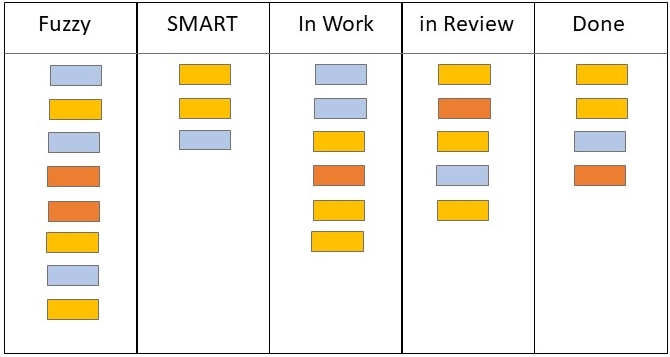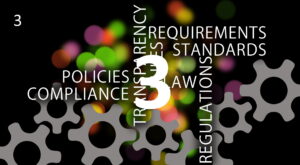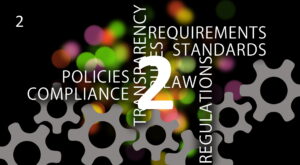
Denkplan © – The action step
Concepts are easy, being actionable is challenging
The action step uses Kanban to lead the roadmap to action. With this the basic approach should be well known. The challenging part in the action step is hidden in the details of living it day to day. The most important part is to find a common and shared understanding how to mature and pull portfolio initiatives through the portfolio Kanban. For sure it is a benefit when all participants play the action game more or less identically. That requires coaching, feedback, communication and a Kaizen approach to improve the action game ongoing.
Companies that already practice agility understand how to develop and evolve good practices over time. If you as company are right in the beginning, this steps offers an opportunity to learn – including the members of the management.
Let’s have a look at the Portfolio Kanban. I personally like to work with a Kanban with status columns as following

The colors of the initiatives in the Kanban board visualize the different themes. Yellow initiatives represent theme A, blue ones theme B and the red ones theme C.
There are some funny lanes in the Kanban: fuzzy and SMART.
Short comment on SAFe
In SAFe the portfolio Kanban lanes are named: funnel, reviewing, analyzing, portfolio backlog, implementing, done. To be frank: for me this sounds like a hidden waterfall. Actually this is one of my personal concerns with SAFe. In some SAFe implementations I had the chance to observe, this construct silently introduced series of three months period waterfalls. Business analysis writes specification for three months until the next PI. Before the PI the organization pushes the analyzed SAFe epics into the agile release trains. In the PI meeting the implementation teams are allowed to estimate and to give some tiny feedback and then the release train engineer horn blows: “start working on this and hurry up”.
Well, to be fair: This is not a problem of SAFe, you can live SAFe in an agile way. Nevertheless, the construct of SAFe with PI’s influences in this direction. More traditional companies tend to fall back in over years trained behavior and live three months waterfalls pushing portfolio epics into the “agile delivery organization”. Already the term “agile delivery organization” implies a client – contractor relationship and not an “we are one organism pulling in the same direction” mindset.
The Kanban visualizes the maturing flow
The reason I name the lanes in the Kanban as in the image above is that is a maturity model of ideas behind. Initiatives mature in different speed. We know from lean startup that it is essential to experiment in real life small steps how a service or product will satisfy customer needs. This experimenting takes its time. It is impossible to say, when the moment arrives that a service or product reaches this point and it is time to scale (or pivot). We follow this idea of lean startup as well with this portfolio Kanban.
What we try to avoid is to mature an initiative to early – this results in wasted upfront work – and to avoid maturing to late – in this case we might miss the perfect time to generate value on customer side. The agile aspect is to meet the perfect point in time to invest effort into a ripe initiatives, maximizing value for customers – and for us. This is an interesting prioritization and maturing game. In complex and fast ecosystems change is fast and proactive action might decide between gain or loss. The portfolio Kanban is the instrument to play this game.
This background of maturing initiatives at the right time for customers is the reason for the lanes fuzzy and SMART. A fuzzy initiative is – well – fuzzy. We do not know much details, but we agree that this feature or service sounds cool. We need more information for fuzzy initiatives to decide about priority in the fuzzy lane. A fuzzy initiative reaches its definition of ready (DoR) when we have enough information to rank it against the other fuzzy initiatives. The fuzzy initiative with the highest priority (in respect of value generation) will be set on top of the fuzzy lane and will next be pulled into the SMART lane as soon as the work in progress (WIP) limit allows this.
Next short comment on SAFe
Please allow a next remark on SAFe as one of the most popular agile scaling frameworks used. Observed from a distance the Denkplan portfolio Kanban may look pretty similar to the SAFe business & enabler epic Kanban. If you look to the Kanban as WIP limit instrument – that might be true.
Nevertheless, the background and principles used to identify, mature and realize items in these Kanban boards have fundamental differences. Queueing theory principles in the SAFe business epic Kanban are week. Lead and cycle time often have tremendous variance and – even worse – business epics are pushed into the Kanban board instead of being pulled. This is not a problem of SAFe, it is a defect in a SAFe implementation. Fact is that SAFe, as it is and used by companies on a still to be developed agility maturity level, seduces to develop these defect behaviors. The business – IT gap is re-established by business epic Kanban.
Next question is: Who does the work to collect and analyze additional information so we can prioritize the initiatives in the fuzzy lane?
Who matures initiatives when?
My agile answer is: (an) autonomous and multi-disciplinary team(s) that permanently acts in the domain of the specific initiative
Definition of terms: domain or subdomain
A domain or subdomain covers a part or section of the value stream of a company with high cohesion within a knowledge area, with common rules and procedures. Example for domains are the product placement knowledge of an online shop or pharmaceutical checks on medical prescriptions
The portfolio roadmap offers the team(s) candidate initiatives to mature; or the teams discover candidate initiatives by themselves and put them on the roadmap. With this the team(s) in a domain know the fuzzy candidates to work on for prioritization. As soon as an initiatives reaches the DoR to be ready for prioritization, the prioritization can be done against all other DoR fuzzy initiatives out of other domains. This is an agenda topic of an recurring event that works with the portfolio Kanban as instrument. More about the events and the cadence will follow in an additional blog. More about how to deal with the maturing of an initiative, if an organization is not yet organized in autonomous teams working in a domain, will be covered as well in an additional blog.
Now we know how an initiatives is pulled from fuzzy into SMART. The game in the SMART lane is analog. This is next step in maturing, whereas we start from a better starting point – an initial idea about priority and business value. The SMART lane now matures an initiative to a maturity level of SMART goals. That’s where the name SMART comes from. With SMART goals we elaborated enough information to reach the goals of this initiatives. The initiative is ready to be pulled into the “in Work” lane. When pulled into the “in Work” lane we concentrate to reach the SMART goals of the initiative within the shortest possible lead time and the minimal effort possible. That is the goal of the “in Work” lane.
All in all the Kanban game shall support the following important aspects:
- Mature initiatives in the appropriate time respecting influence of market, technology, competition and organization.
- Prioritize based on value creation for customers and company.
- Have clear Definitions of ready to check the maturity status of an initiative.
- Invest least effort into the maturing process before realization of the value.
- Created focus and strive to reach the SMART goals of an initiative with minimal effort in the shortest possible lead time.
Why does a review lane exist?
The “in Review” lane might sound a bit strange. Why is a review necessary? The outcome is available when the DoR of the “in Work” lane is reached; customers and users can work with the outcome and generate value. So, what are we waiting for while sitting in the “in Review” lane? Reason is to determine the desired impact. The outcome maybe there and the service or product is used by the customers, but the desired impact requires eventually some time of operation to collect figures. Hopefully the figures to observe are part of the SMART goal definition in the initiatives. Defining these figures to evaluate the impact of an initiatives are important acceptance criteria of an initiative. Ideally the teams implement the measurements with or even before the implementation of the results. This is analog to agile software development. The acceptance criteria are the templates for automated tests to be written. In a TDD (test driven design) approach automated tests are written before source code of the software is written. IT people understand this analogy – I hope business people apologize this technical excurse.
The DoR of the “in Review” lane is reached when we evaluated the impact. This probably results in new ideas for initiatives – and the game starts all over.
Is implementation allowed while being fuzzy?
There are many questions open around this Kanban game. I would be happy to receive your questions to discuss.
One of the most asked questions is: “Is it allowed to implement a piece of software if an initiatives is still in the fuzzy or SMART lane?” The answer is obvious: Yes. And what is the reason why?
Remember, its is an maturing process. An initiatives is mature if all of the following constraints are fulfilled:
- business people say the market and the customer are ready to consume.
- IT people say that it is possible to implement the required software including architectural aspects while keeping the health of the overall IT systems above the desired level.
- The organization is ready in time to provide the service, i.e. internal users are trained, infrastructure is ready (infrastructure is more than IT infrastructure, imagine the initiative is the opening of a new flagship store in a big city) and whatever is required to operate the outcome.
With this in mind, yes for sure it is allowed to “implement” when a initiative is still in the fuzzy lane. The flagship store is a good example. While in the fuzzy lane you check for example the situation of the real estate market in the target area to get a feeling how feasible it is at all to find an attractive location. Maybe you have to check if the IT systems can support a flagship store logistic and you implement a spike using two or three user stories in a current sprint – and so on. You see the game.
Again: autonomous teams working ongoing in a specific domain learn to play the game when to invest into a which initiative to establish the flow.
An non discussed impediment is: How to act, if the focus moves from one domain to another domain with the effect that more capacity will be needed in domain A in the future and less in domain B. This is as well a question of a future blog.
Denkplan © and the concepts behind is a registered trademark of DoD!fferent GmbH, Saraes Media GmbH and Juropera GmbH.
 Previous Post
Previous Post Next Post
Next Post

